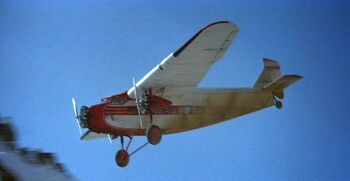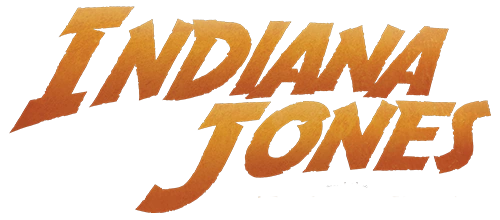| Line 21: | Line 21: | ||
==Appearances== |
==Appearances== |
||
| − | *''[[Indiana Jones and the Temple of Doom]]'' |
+ | *''[[Indiana Jones and the Temple of Doom]]'' |
| + | *''[[Indiana Jones and the Army of the Dead]]'' |
||
==Sources== |
==Sources== |
||
Revision as of 23:28, 21 October 2009

Ford Tri-Motor in flight.
Indiana Jones and the Temple of Doom
The Ford Tri-Motor Airplane was an airplane built by Ford between 1925 and 1933. Built entirely out of metal (and thus nicknamed the "Tin Goose"), it was designed to be a passenger plane, but often was converted to cargo or military uses. Using a single propeller engine in the fuselage, and an engine on each wing, the plane was considered to be relatively inexpensive and reliable. With a range of only 500 miles, it was capable of crossing continents with refueling stops. Even with less than 200 planes produced, the model was admired by aviators such as Amelia Earhart and Charles Lindbergh.
History
Lao Che Air Freight owned a Ford Tri-Motor for cargo flights across Asia. It had a small cockpit for two pilots, a main cargo area, and a separated area in the tail.
In 1935, one such flight was scheduled to depart from Shanghai's Nang Tao Airport in the evening, when Earl Weber booked passage for Indiana Jones, Short Round, and Willie Scott on the first available flight from the city - and it happened to be on the Ford Tri-Motor, carrying a load of poultry to Bangkok, Siam.[1]. As Jones and his friends hurried aboard, the pilot took off, leaving Jones' pursuers - Lao Che's associates on the ground. Jones used the small tail area to change from his tuxedo into his adventuring clothes before falling asleep.
Determining that killing Jones was worth the cost of the plane, Lao Che signaled the pilot and co-pilot to ditch the plane. After refueling in Chungking, the plane traveled west instead of south towards the scheduled destination. While the passengers slept, the pilots dumped the fuel, took the only parachutes aboard and jumped to safety over the eastern Siwalik range[2]. Jones and his companions awoke, realized that a crash was unavoidable, and jumped out of the plane with an inflatable raft. The plane crashed into a mountaintop near the Pindari Glacier.
After the encounter, Jones found an instruction manual for a Ford Trimotor and kept it in his journal, along with a note to learn how to fly a plane. By 1938, he had learned how to fly a plane, but not land.[3]
Behind the scenes
Scenes in Indiana Jones and the Temple of Doom depicting the Ford tri-motor used both a real Ford tri-motor and several models. One model with a three-foot wingspan was built by ILM's Michael Fulmer and Ira Keeler, and filmed over a snowy mountain set, on the roof of ILM's main stage. A smaller model was used for the pyrotechnic shots for the crash and explosion.[4] A model with a six-foot wingspan was used for detailed shots, while a mock-up of the cockpit was made for cockpit scenes.
The scene in which the plane is shown flying over the Great Wall of China was done with models of both the plane and the landscape, and is possibly a continuity error. The Great Wall of China is located in northern China, and not along the flight route shown in the montage (heading soutwest from Shanghai) towards Chungking and on towards India.
The actual plane used in the filming of Temple of Doom is currently part of the collection of Fantasy of Flight, located in Polk City, Florida.
In a 2005 episode of MythBusters, the MythBusters team debunked the plausibility of sitting in a life raft as a way to survive a fall from an airplane, as shown in the film.
Appearances
Sources
- From Star Wars To Indiana Jones - The Best of the Lucasfilm Archives
- Indiana Jones: The Ultimate Guide
- The Lost Journal of Indiana Jones
Notes and references
- ↑ Indiana Jones: The Ultimate Guide says that Short Round had arranged for three seats, although this could mean that he had instructed Weber to do so.
- ↑ Indiana Jones: The Ultimate Guide
- ↑ The Lost Journal of Indiana Jones
- ↑ From Star Wars To Indiana Jones - The Best of the Lucasfilm Archives
